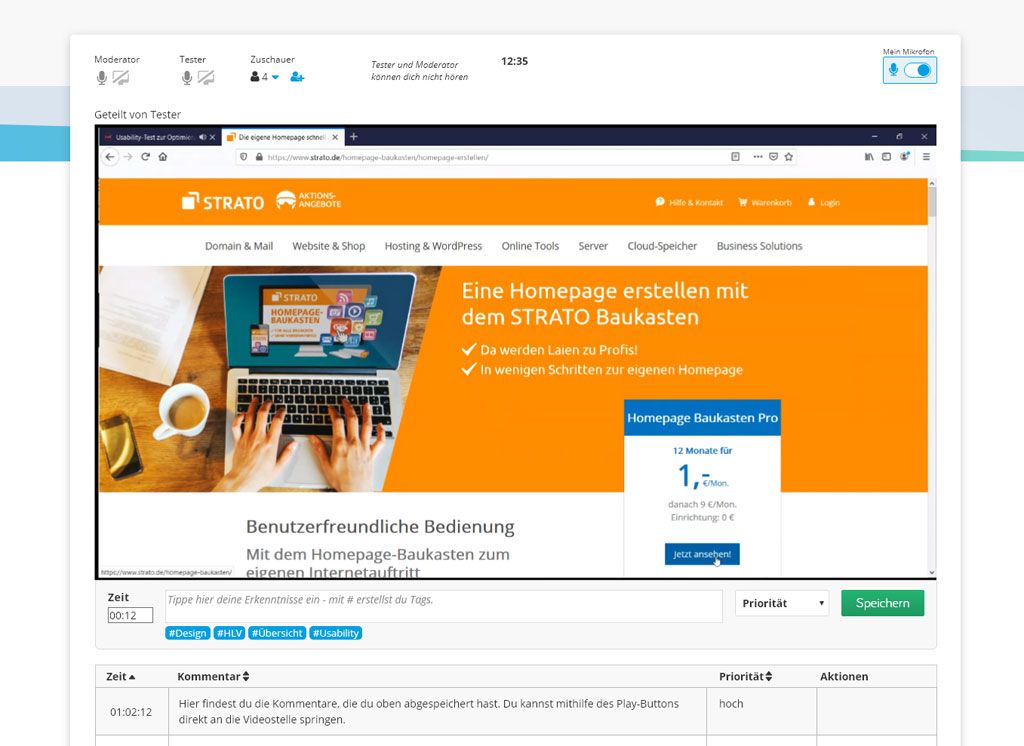Table of contents
1. Introduction
1.1 Success factors
2. Make UX tangible and make the case for it to your colleagues
2.1 (Virtual) eye-tracking
2.2 Poor UX KPIs
2.3 Negative customer feedback
2.4 Internal UX workshops
3. Get backing from management
3.1 Calculate return on investment
3.2 Listen
4. RapidUsertests supports you in making your case to your stakeholders
4.1 Let your stakeholders watch live
4.2 Share video moments
4.3 Highlight videos
4.4 Allocate guest access and evaluate tests together
1. Introduction
There is one thing in particular that big companies like Apple, Google and Amazon as well as online shops like Mister Spex and Zalando have in common: Their entire product development process is user-centred.
But how do you implement this type of thinking within a team? How can you convince management that user experience and usability improvements bring decisive competitive advantages? How do you motivate your colleagues to collect customer opinions, carry out user research and make UX an integral component of the development process?
Here, even sound arguments are often not enough. In this article, you will find out what really works.
1.1 Success factors
How can usability measures be integrated into the development processes of SMEs successfully and lastingly? A dissertation from TU Berlin took a closer look at this question and identified two essential success factors (sources):
- Making UX tangible
- Backing from management
What exactly does this mean and how can it be achieved?
2. Make UX tangible and make the case for it to your colleagues
What is more convincing?
“Many shop visitors are exiting on the product detail page. This could be due to a lack of information.”
or
“We have done a test with 15 users and 11 were unable to find information on the dimensions of the table. We should make this information more prominent.”
To make the case for the UX potential of a website or app, concrete examples and calculations are better than assumptions and theoretical arguments. In this way, you can also make sure that your colleagues will continue to make use of UX methods in the future.
Methods through which you can make UX tangible to both your colleagues and management:
2.1 (Virtual) eye-tracking
Virtual eye-tracking (explanation in English) is an affordable alternative to eye-tracking in the usability lab. Using visual heatmaps, an AI marks attention-rich and attention-poor areas on a webpage. The presentation of these attention maps alone can make quite an impression.
To complement this, a convincing case for the results would sound as follows:
“Our analytics data shows that the search function is barely being utilised. Eye-tracking has revealed that users don’t even see it. We should position it more prominently and carry out A/B testing with the new version.”
A heat map displays a landing page’s most attention-rich areas.
2.2 Poor UX KPIs
Can KPIs such as customer satisfaction, bounce rate, conversion rate, etc. be traced back to poor UX or usability? Present these correlations to your team and calculate the (economic) benefits of improving the user experience.
Instead of
“50% of users jump off on the last checkout page. We have to find out why this is the case.”
be more convincing and say
“Because 50% of users jump off on the last checkout page, we are losing at least €100,000 per month. Using a usability test, we could find out what’s causing the jump-offs.”
2.3 Negative customer feedback
Specific quotes from your customers are more likely to encourage your stakeholders to revise your UX than your own assumptions:
“40% of support requests are about our shipping terms. Analytics data, however, has shown that the actual page dealing with this rarely visited. Last week, a customer wrote:
‘Do you ship to Austria? I can’t find anything about this on your website, but I would like to order from you because you offer the backpack at the lowest price. I need a quick answer because this is supposed to a present.’
Because of this, we should communicate this information more clearly.”
Your customer support team will surely be able to provide you with insights into some of these problems, concerns and challenges. Collect customer voices in a structured manner that may be indicative of usability issues on your website or app and use them to make your case. Letting users speak for themselves is especially effective. Carry out remote usability tests (e.g. with RapidUsertests.com) and share key excerpts from the result videos with your team. In this way, they get to see and hear the issues directly, which in turn will allow you to come up with solutions together.
“One of our pop-ups is causing booking cancellations:
3 testers have received the pop-up and they all thought their accommodation was already booked.”
2.4 Internal UX workshops
Give your colleagues insight into your work and let them participate in a UX project. This could, for example, be a heuristic evaluation, a paper prototype or a usability test of a prototype or of your live webpage. In this way, they will come to understand how little time and effort is involved in the realisation of such a project. At the end of the project, you should discuss how these methods could be incorporated into the daily work routine in the future.
3. Get backing from management
To make the case for the importance of good user experience and to move forward the implementation of UX work at your company, a little more is required than the points mentioned above. Management is less motivated by how you plan on solving existing problems than they are by the exact return they can expect.
3.1 Calculate return on investment
Have you ever implemented UX and usability measures? Then calculate the actual return on investment (ROI) for these projects and make the case for them to your management. In this way, you will also learn how to estimate the ROI for future projects and achieve budget approvals. How exactly to calculate ROI is something we explain here:
- This is how you calculate the ROI of your usability tests (in German)
- Make UX measurable and strengthen your company’s UX culture
- The 7 most important UX KPIs and how to measure them
3.2 Listen
In his article “Why I can’t convince executives to invest in UX (and neither can you)”, usability expert Jared Spol reveals his strategy when it comes to making the case to invest in UX to management: Speech is silver, listening is golden. It may sound trite, but it’s essential. Listen to your boss when he or she are talking about worries and challenges. What’s keeping your boss unhappy? What would they like to improve? Base your case on this and explain to them how you will be able to pull these improvements off (spoiler: It’s probably got has something to do with UX).
4. RapidUsertests supports you in making your case to your stakeholders
With RapidUsertests.com, we have developed a tool for moderated and unmoderated remote-usability tests. It offers different ways to inspire your colleagues and management to give user-focused product development a try:
4.1 Let your stakeholders watch live
Up to 30 viewers can participate in your moderated remote tests. In other words, you can invite your whole team if you like. Testers won’t notice a thing and will therefore not feel intimidated by having to perform in front of such a big audience.
All viewers can use our tool to take live notes which will later be available in the exact same spot in the video timeline — this will make evaluation much easier at the end.
Since viewers are located in their own virtual room, they can communicate with one another without disturbing moderators and testers. Perfect for remote teams!

Viewers can watch live during the test and take notes.
4.2 Share video moments
Has the usability test led to insights that you would now like to quickly share with the rest of your team? As per the motto “Show, don’t tell”, you can easily share your notes and the corresponding moments in the video via a link. This will make usability issues tangible for your team and you get to awaken their UX spirit.
- How to reach your stakeholders after a usability test (in German)
- Demonstrate the value of your work and strengthen your company’s UX culture
4.3 Highlight videos
We even go one step further: In addition to the individual video moments, you can edit together a highlight video using our evaluation tool. With a compilation of the most important user scenes, you can clearly illustrate and present the results of the whole test to your stakeholders.
What’s best: The highlight video basically creates itself while you evaluate the usability test.
4.4 Allocate guest access and evaluate tests together
In order to demonstrate how you evaluate a usability test and then continue to work with the results, you easily provide your colleagues and superiors with access to your tests results. They receive access to all the videos from your usability test, see your notes and can add their own notes. In this way, you can evaluate tests together, for example, as part of an internal UX workshop.
Sources
- Stade, M. C., Brandenburg, S. & Reckin, R. (2015). Usabiltiy-Maßnahmen bei KMU als Teil des Entwicklungsprozesses etablieren: Eine erste Evaluation eines Vorgehensmodells. In A. Schmidt, A. Weisbecker & M. Burmester (Hrsg.). Mensch und Computer 2015 Workshopband, Stuttgart: Oldenbourg Wissenschaftsverlag, pp. 577-586.
- Brandenburg, S., Sachse, K., Jager, A., Reckin, R., & Becker, M. (2016). Usability für kleine und mittelständische Unternehmen im Bereich mobiler und internetbasierter Anwendungen. In: M. Thüring, J. Prümper, B. Schmitz, & M. Friedrich. Abschlussbericht von UseTree, dem Berliner Kompetenzzentrum für Usability-Maßnahmen.

